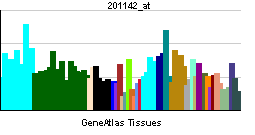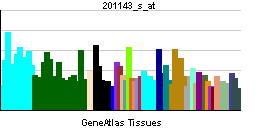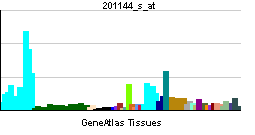EIF2S1
| Eukaryotic translation initiation factor 2, subunit 1 alpha, 35kDa | |||||||||||||
|---|---|---|---|---|---|---|---|---|---|---|---|---|---|
 PDB rendering based on 1kl9. | |||||||||||||
| |||||||||||||
| Identifiers | |||||||||||||
| Symbols | EIF2S1 ; EIF-2; EIF-2A; EIF-2alpha; EIF2; EIF2A | ||||||||||||
| External IDs | Template:OMIM5 Template:MGI HomoloGene: 3020 | ||||||||||||
| |||||||||||||
| RNA expression pattern | |||||||||||||
 | |||||||||||||
 | |||||||||||||
 | |||||||||||||
| More reference expression data | |||||||||||||
| Orthologs | |||||||||||||
| Template:GNF Ortholog box | |||||||||||||
| Species | Human | Mouse | |||||||||||
| Entrez | n/a | n/a | |||||||||||
| Ensembl | n/a | n/a | |||||||||||
| UniProt | n/a | n/a | |||||||||||
| RefSeq (mRNA) | n/a | n/a | |||||||||||
| RefSeq (protein) | n/a | n/a | |||||||||||
| Location (UCSC) | n/a | n/a | |||||||||||
| PubMed search | n/a | n/a | |||||||||||
Eukaryotic translation initiation factor 2, subunit 1 alpha, 35kDa, also known as EIF2S1, is a human gene.[1]
The translation initiation factor eIF2 catalyzes the first regulated step of protein synthesis initiation, promoting the binding of the initiator tRNA to 40S ribosomal subunits. Binding occurs as a ternary complex of methionyl-tRNA, eIF2, and GTP. eIF2 is composed of 3 nonidentical subunits, alpha (36 kD), beta (38 kD, MIM 603908), and gamma (52 kD, MIM 300161). The rate of formation of the ternary complex is modulated by the phosphorylation state of eIF2-alpha (Ernst et al., 1987).[supplied by OMIM][1]
References
Further reading
- Hershey JW (1991). "Translational control in mammalian cells". Annu. Rev. Biochem. 60: 717–55. doi:10.1146/annurev.bi.60.070191.003441. PMID 1883206.
- Mao X, Green JM, Safer B; et al. (1992). "Regulation of translation initiation factor gene expression during human T cell activation". J. Biol. Chem. 267 (28): 20444–50. PMID 1400363.
- Mellor H, Proud CG (1991). "A synthetic peptide substrate for initiation factor-2 kinases". Biochem. Biophys. Res. Commun. 178 (2): 430–7. PMID 1677563.
- Green SR, Spalding A, Ashford T; et al. (1992). "Synthesis of human initiation factor-2 alpha in Saccharomyces cerevisiae". Gene. 108 (2): 253–8. PMID 1748310.
- Kramer G (1990). "Two phosphorylation sites on eIF-2 alpha". FEBS Lett. 267 (2): 181–2. PMID 2116318.
- Ernst H, Duncan RF, Hershey JW (1987). "Cloning and sequencing of complementary DNAs encoding the alpha-subunit of translational initiation factor eIF-2. Characterization of the protein and its messenger RNA". J. Biol. Chem. 262 (3): 1206–12. PMID 2948954.
- Kato S, Sekine S, Oh SW; et al. (1995). "Construction of a human full-length cDNA bank". Gene. 150 (2): 243–50. PMID 7821789.
- Ray MK, Chakraborty A, Datta B; et al. (1993). "Characteristics of the eukaryotic initiation factor 2 associated 67-kDa polypeptide". Biochemistry. 32 (19): 5151–9. PMID 8098621.
- Dever TE, Chen JJ, Barber GN; et al. (1993). "Mammalian eukaryotic initiation factor 2 alpha kinases functionally substitute for GCN2 protein kinase in the GCN4 translational control mechanism of yeast". Proc. Natl. Acad. Sci. U.S.A. 90 (10): 4616–20. PMID 8099443.
- Barber GN, Wambach M, Wong ML; et al. (1993). "Translational regulation by the interferon-induced double-stranded-RNA-activated 68-kDa protein kinase". Proc. Natl. Acad. Sci. U.S.A. 90 (10): 4621–5. PMID 8099444.
- Miyamoto S, Chiorini JA, Urcelay E, Safer B (1996). "Regulation of gene expression for translation initiation factor eIF-2 alpha: importance of the 3' untranslated region". Biochem. J. 315 ( Pt 3): 791–8. PMID 8645159.
- Yang W, Hinnebusch AG (1996). "Identification of a regulatory subcomplex in the guanine nucleotide exchange factor eIF2B that mediates inhibition by phosphorylated eIF2". Mol. Cell. Biol. 16 (11): 6603–16. PMID 8887689.
- Brand SR, Kobayashi R, Mathews MB (1997). "The Tat protein of human immunodeficiency virus type 1 is a substrate and inhibitor of the interferon-induced, virally activated protein kinase, PKR". J. Biol. Chem. 272 (13): 8388–95. PMID 9079663.
- Ting NS, Kao PN, Chan DW; et al. (1998). "DNA-dependent protein kinase interacts with antigen receptor response element binding proteins NF90 and NF45". J. Biol. Chem. 273 (4): 2136–45. PMID 9442054.
- Kimball SR, Heinzinger NK, Horetsky RL, Jefferson LS (1998). "Identification of interprotein interactions between the subunits of eukaryotic initiation factors eIF2 and eIF2B". J. Biol. Chem. 273 (5): 3039–44. PMID 9446619.
- Shi Y, Vattem KM, Sood R; et al. (1998). "Identification and characterization of pancreatic eukaryotic initiation factor 2 alpha-subunit kinase, PEK, involved in translational control". Mol. Cell. Biol. 18 (12): 7499–509. PMID 9819435.
- Satoh S, Hijikata M, Handa H, Shimotohno K (1999). "Caspase-mediated cleavage of eukaryotic translation initiation factor subunit 2alpha". Biochem. J. 342 ( Pt 1): 65–70. PMID 10432301.
- Berlanga JJ, Santoyo J, De Haro C (1999). "Characterization of a mammalian homolog of the GCN2 eukaryotic initiation factor 2alpha kinase". Eur. J. Biochem. 265 (2): 754–62. PMID 10504407.
- Lu J, O'Hara EB, Trieselmann BA; et al. (1999). "The interferon-induced double-stranded RNA-activated protein kinase PKR will phosphorylate serine, threonine, or tyrosine at residue 51 in eukaryotic initiation factor 2alpha". J. Biol. Chem. 274 (45): 32198–203. PMID 10542257.
| This protein-related article is a stub. You can help Wikipedia by expanding it. |